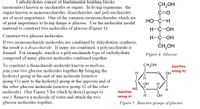
5.When dehydration occurs, do molecules join together or is a molecule split apart?_________________________________________________________________________
6.Does hydrolysis involve the addition of water to a molecule or the loss of water from a molecule? _________________________________________________________________________
7.When hydrolysis occurs, do molecules join together or is a molecule split apart?

-When dehydration occurs the molecules of carbohydrates (monosaccharides) are joined together to form disaccharides or polysaccharides(starch).
-Disaccharides are formed when two monosaccharides are joined together by the process of dehydration, when more than two molecules of monosaccharides are combined together through dehydration reaction , it forms polysaccharides(starch).
Answer: Hence answer to question-5 is , when dehydration occurs the molecules of carbohydrates join together.
Step by stepSolved in 3 steps

- 10arrow_forward( explain well with proper answer with each step.)arrow_forwardSelect the best answer or answers from the choices given: All of the following are examples of the four major elements contributing to body mass except (a) hydrogen, (b) carbon, (c) nitrogen, (d) sodium, (e) oxygen.arrow_forward
- Fill in the blanks: Osmosis is the movement of ______________ from a __________________ concentration to a _______________________.arrow_forwardDefine the following terms: a. aliphatic hydrocarbon b. amino acid c. neurotransmitter d. hormone e. zwitterionarrow_forwardCan someone please help me with this if anyone is reading this pls help I need help with the questions Thank you!!arrow_forward
- Answer the given questions. Draw clearly what is given and FOLLOW INSTRUCTIONS.arrow_forwardGroup the following compounds based on their presence in DNA or RNA or DNA & RNA? Guanine Cytosine D-Ribose Thymine Uracil D- Deoxyribosearrow_forwardIn 3-4 sentence explain how carbohydrates, lipids, proteins, and nucleic acids have in common and why we need them.arrow_forward
- Answer 1 and 2 quickly pleasearrow_forwardWhat is arteriosclerosis? Relate such in lipid. Include pictures of someone with arteriosclerosis.arrow_forwardIdentify if the statement is True or False. If the statement is false, identify what is incorrect and correct it. 1. Liquefactive necrosis is a pattern of cell death characterized by dissolution of necrotic cells (example: abscess) 2. Electrons are frequently added to O2 to create biologically important ROS (.OH, H2O2 and O2-). Free radical is unpaired electron which makes the atom or molecule less reactive. DNA damages can lead to cell severe injury, and apoptosis. An improperly folded proteins can also initiate apoptosis. 3.arrow_forward
 Human Anatomy & Physiology (11th Edition)BiologyISBN:9780134580999Author:Elaine N. Marieb, Katja N. HoehnPublisher:PEARSON
Human Anatomy & Physiology (11th Edition)BiologyISBN:9780134580999Author:Elaine N. Marieb, Katja N. HoehnPublisher:PEARSON Biology 2eBiologyISBN:9781947172517Author:Matthew Douglas, Jung Choi, Mary Ann ClarkPublisher:OpenStax
Biology 2eBiologyISBN:9781947172517Author:Matthew Douglas, Jung Choi, Mary Ann ClarkPublisher:OpenStax Anatomy & PhysiologyBiologyISBN:9781259398629Author:McKinley, Michael P., O'loughlin, Valerie Dean, Bidle, Theresa StouterPublisher:Mcgraw Hill Education,
Anatomy & PhysiologyBiologyISBN:9781259398629Author:McKinley, Michael P., O'loughlin, Valerie Dean, Bidle, Theresa StouterPublisher:Mcgraw Hill Education, Molecular Biology of the Cell (Sixth Edition)BiologyISBN:9780815344322Author:Bruce Alberts, Alexander D. Johnson, Julian Lewis, David Morgan, Martin Raff, Keith Roberts, Peter WalterPublisher:W. W. Norton & Company
Molecular Biology of the Cell (Sixth Edition)BiologyISBN:9780815344322Author:Bruce Alberts, Alexander D. Johnson, Julian Lewis, David Morgan, Martin Raff, Keith Roberts, Peter WalterPublisher:W. W. Norton & Company Laboratory Manual For Human Anatomy & PhysiologyBiologyISBN:9781260159363Author:Martin, Terry R., Prentice-craver, CynthiaPublisher:McGraw-Hill Publishing Co.
Laboratory Manual For Human Anatomy & PhysiologyBiologyISBN:9781260159363Author:Martin, Terry R., Prentice-craver, CynthiaPublisher:McGraw-Hill Publishing Co. Inquiry Into Life (16th Edition)BiologyISBN:9781260231700Author:Sylvia S. Mader, Michael WindelspechtPublisher:McGraw Hill Education
Inquiry Into Life (16th Edition)BiologyISBN:9781260231700Author:Sylvia S. Mader, Michael WindelspechtPublisher:McGraw Hill Education





